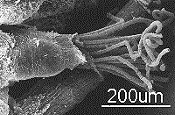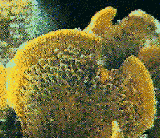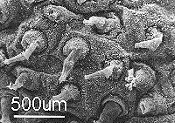![]()
When scientists noticed what appeared to be brown golf balls floating in the Weddell Sea, Antarctica, they thought they were worth a closer look. They were subsequently found to be colonies of bryozoans (moss animals), which are normally found firmly attached to rocks.
They were found to be the first
free-swimming bryozoan colonies ever recorded.
What were they doing there and were they a new species....read
this illustrated article by Dave Walker to find out! Based on
articles and illustrations provided by Lloyd Peck of the British
Antarctic Survey and the Natural Environment Research Council.
 What
is a Bryozoan?
What
is a Bryozoan?
Why is this Bryozoan Unusual?
Is the Bryozoan a New Species?
Questions Unanswered
Acknowledgments and Further Reading
What is a Bryozoan?
Bryozoans are colonial microscopic animals that occur in both
freshwater and seawater. They are often known as moss animals.
Members of the group form colonies of varying size and shape and
grow on other objects such as rocks, seaweed or ship hulls.
Encrusting colonies usually grow over rocks forming a layer,
whereas upright colonies are attached at the base and grow up as
a sheet (an example of an upright form is shown left below).
 The texture of a
colony varies from either being soft and gelatinous, or tufted
with leaf-like fronds or forming hard calcified skeletons like a
coral. The colonies are formed of individual zooids, each of
which is a complete organism. Most zooids have ciliated tentacles
that propel food particles to the simple mouth of the animal. The
zooids are connected to the matrix of the colony and can interact
with other colony members by tiny pores in their body walls.
The texture of a
colony varies from either being soft and gelatinous, or tufted
with leaf-like fronds or forming hard calcified skeletons like a
coral. The colonies are formed of individual zooids, each of
which is a complete organism. Most zooids have ciliated tentacles
that propel food particles to the simple mouth of the animal. The
zooids are connected to the matrix of the colony and can interact
with other colony members by tiny pores in their body walls.
 The image
on the right shows a group of zooids on the surface of the new
bryozoan colony, and the image at the top of this article a
close-up of an individual zooid. The white bar indicates the
length in microns (1/1000th mm). The ring of tentacles form what
is termed the lophophore which retract when the colony is
disturbed.
The image
on the right shows a group of zooids on the surface of the new
bryozoan colony, and the image at the top of this article a
close-up of an individual zooid. The white bar indicates the
length in microns (1/1000th mm). The ring of tentacles form what
is termed the lophophore which retract when the colony is
disturbed.
Why is this Bryozoan Unusual?
When the floating golf balls were first collected in a bucket by
intrigued scientists on a British Antarctic Survey supply ship,
they had no idea what they were. They were brought to Lloyd Peck
a BAS scientist working on South Georgia Island who had a quick
look before preserving them and sending them to England.
Llloyd said "At first I did not have a clue and thought they were some sort of gelatinous sea-gooseberry-like-thing". He preserved them in an old coffee jar but it was a year later before he had a chance to study them under a microscope at the BAS headquarters in Cambridge, England.
The light brown spheres are up to 3cm across and close study of them soon revealed that they were not only the first free-swimming bryozoan colonies ever recorded but also the first hollow colony for the Bryozoa phylum.
The site where they were found is 400m deep and some distance from the normal bryozoan habitats. So why were they there and what do they feed on?
The area where they were found remains free of sea ice for most of the year (a so-called polynya) and would have more plankton present than under the surrounding ice because the light levels are higher. This may therefore provide a richer food supply for the bryozoan.
Another possibility is that the colonies may feed on the microscopic algae that grows on the under-layer of sea-ice in this area. It is suspected that the colonies may have been released from under the sea ice because of ice break-up. Thus free bryozoan colonies have two potential advantages over bottom-dwelling species in terms of food acquisition.
A further advantage is that mobile species are able to exploit patchy food resources which are some distance apart. This is important because the plankton levels in the Weddell Sea are very seasonal. At some times of the year the absence of plankton gives this area the world's clearest sea water.
Is the Bryozoan a New Species?
Scientists currently speculate that the new bryozoan may be a
juvenile bryozoan of the genus Alcyonidium. The species of
this genus are difficult to characterise, hence the uncertainty
and reluctance to assign the brozoan as a new species. Thus as
the young colony increases in size the colony sinks to the bottom
and becomes attached to a substrate.
Questions unanswered
Although some aspects of the organisms existence are now probably
understood. A number of questions below remain unanswered.
Is it a new species or a mobile juvenile form of a
bottom-dwelling species?
When did the free-floating lifestyle arise, and was it more
common in fossil species?
Why is this type of bryozoan only found under Antarctic sea ice?
Why have these type of bryozoan not been found before?
A possible answer to the last question, is that if the new bryozoan is a juvenile form of a bottom-dweller that feeds under the sea-ice, it may be difficult to spot, especially if they only occur for short periods and are sparsely distributed.
This article illustrates that there is still a lot we do not know about the world around us, especially in the icy wastes and seas of Antarctica!
Acknowledgments and Further Reading
The author would like to thank Lloyd Peck of the British
Antarctic Survey for his cooperation and for providing the
original papers on which this article is based.
The author would also like to thank the Natural Environment Research Council for permission to use the illustrations above from their magazine "NERC News".
Visit the Natural Environment Research Council and the British Antarctic Survey web sites.
The above article is based on the following references.
1) "A New Type of Bryozoan from Antarctica"
by L Peck, G Morgan & J Shanklin. NERC News, October 1995,
p25-27.
2) "A Pelagic Bryozoan from Antarctica" by L S
Peck, P J Hayward & M E Spencer-Jones. Marine Biology 1995,
123, p757-762.
3) New Scientist, 13 January 1996, p7.
4) Encyclopaedia Britannica 1993, 15th Edition.
Please report any Web problems
or offer general comments to the Micscape Editor,
via the contact on current Micscape Index.
Micscape is the on-line monthly
magazine of the Microscopy UK web
site at Microscopy-UK